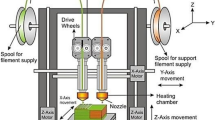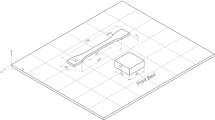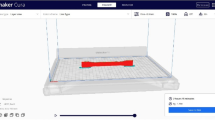Abstract
Fused Deposition Modeling (FDM) is an extrusion-based additive manufacturing technique which growing rapidly due to its ability to fabricate complex parts directly from CAD models. In conjunction with its growing applications, the mechanical behavior of the FDM printed part needs thorough investigation for effective application as an end use functional part in various industries such as aerospace, automobile, mold and die, biomedical. Functional applications of FDM printed parts are affected due to their lower mechanical properties compared to injection molded parts. The assessment of the mechanical behavior of the FDM printed part is proved as challenging task due to the wide variety of the process parameters. In the present work, an attempt has been made to experimentally investigate the tensile behavior of FDM printed parts having multi-Infill patterns and different stacking of layer arrangements for different Infill density and raster orientations. Combined patterned parts are printed from two thermoplastic materials, viz. PLA and ABS having six different stacking sequences at three different levels of Infill density (i.e., 30%, 60% and 90%) and two different raster arrangements (i.e., 0° and 45°) and those are mechanically tested to obtain tensile properties. Further, the fractographic analysis was carried out to study various aspects of tensile failure modes for FDM printed multi-infill pattern samples. Combining two different infill patterns and layer stacking sequence improves tensile strength for 45° raster orientation samples and decreases tensile strength for 0° raster orientation samples when compared to a single pattern throughout. For 0° raster orientation, stacking sequence with all the layers are deposited parallel to loading direction offers more strength than multi-infill pattern samples. Whereas for 45° raster orientation, stacking sequence with all the layers parallel to loading direction offers lower strength than multi-infill pattern samples.






















Similar content being viewed by others
References
Akhoundi B, Behravesh AH, Bagheri Saed A (2018) Improving mechanical properties of continuous fiber-reinforced thermoplastic composites produced by FDM 3D printer. J Reinf Plast Compos 38(3):99–116. https://doi.org/10.1177/0731684418807300
Chua CK, Leong KF, Lim CS (2010) Rapid prototyping: principles and applications, 2nd edn. World Scientific, Singapore
Dave HK, Prajapati AR, Rajpurohit SR, Patadiya NH, Raval HK (2020) Investigation on tensile strength and failure modes of FDM printed part using in-house fabricated PLA filament. Adv Mater Process Technol. https://doi.org/10.1080/2374068X.2020.1829951
Popescu D, Zapciu A, Amza C, Baciu F, Marinescu R (2018) FDM process parameters influence over the mechanical properties of polymer specimens: a review. Polym Test 69:157–166. https://doi.org/10.1016/j.polymertesting.2018.05.020
Ahn SH, Montero M, Odell D, Roundy S, Wright PK (2002) Anisotropic material properties of fused deposition modeling ABS. Rapid Prototyp J 8:248–257. https://doi.org/10.1108/13552540210441166
Mohamed OA, Masood SH, Bhowmik JL (2016) Optimization of fused deposition modeling process parameters for dimensional accuracy using I-optimality criterion. Measurement 81:174–196. https://doi.org/10.1016/j.measurement.2015.12.011
Bamiduro O, Owolabi G, Haile MA, Riddick JC (2015) The influence of load direction, microstructure, raster orientation on the quasi-static response of fused deposition modeling ABS. Rapid Prototyp J 25:462–472. https://doi.org/10.1108/RPJ-04-2018-0087
Dawoud M, Taha I, Ebeid SJ (2016) Mechanical behaviour of ABS: An experimental study using FDM and injection moulding techniques. J Manuf Process 21:39–45. https://doi.org/10.1016/j.jmapro.2015.11.002
Uddin MS, Sidek MFR, Faizal MA, Ghomashchi R, Pramanik A (2017) Evaluating mechanical properties and failure mechanisms of fused deposition modeling acrylonitrile butadiene styrene parts. J Manuf Sci E 139:081018. https://doi.org/10.1115/1.4036713
Durgun I, Ertan R (2014) Experimental investigation of FDM process for improvement of mechanical properties and production cost. Rapid Prototyp J 20:228–235. https://doi.org/10.1108/RPJ-10-2012-0091
Li H, Wang T, Sun J, Yu Z (2018) The effect of process parameters in fused deposition modelling on bonding degree and mechanical properties. Rapid Prototyp J 24:80–92. https://doi.org/10.1108/RPJ-06-2016-0090
Casavola C, Cazzato A, Moramarco V, Pappalettere C (2016) Orthotropic mechanical properties of fused deposition modelling parts described by classical laminate theory. Mater Des 90:453–458. https://doi.org/10.1016/j.matdes.2015.11.009
Chacon JM, Caminero MA, Garcia-Plaza E, Nunez PJ (2017) Additive manufacturing of PLA structures using fused deposition modelling: effect of process parameters on mechanical properties and their optimal selection. Mater Des 124:143–157. https://doi.org/10.1016/j.matdes.2017.03.065
Rajpurohit SR, Dave HK (2018) Effect of process parameters on tensile strength of FDM printed PLA part. Rapid Prototyp J 24:1317–1324. https://doi.org/10.1108/RPJ-06-2017-0134
Dave HK, Patadiya NH, Prajapati AR, Rajpurohit SR (2019) Effect of infill pattern and infill density at varying part orientation on tensile properties of fused deposition modeling-printed poly-lactic acid part. P I Mech Eng C-J Mec. https://doi.org/10.1177/2F0954406219856383
Rodriguez JF, Thomas JP, Renaud JE (2001) Mechanical behavior of acrylonitrile butadiene styrene (ABS) fused deposition materials: Experimental investigation. Rapid Prototyp J 7:148–158. https://doi.org/10.1108/13552540110395547
Lederle F, Meyer F, Brunotte GP, Kaldun C, Hübner EG (2016) Improved mechanical properties of 3D-printed parts by fused deposition modeling processed under the exclusion of oxygen. Prog Addit Manuf 1:3–7. https://doi.org/10.1007/s40964-016-0010-y
Wu W, Geng P, Li G, Zhao D, Zhang H, Zhao J (2015) Influence of layer thickness and raster angle on the mechanical properties of 3D-printed PEEK and a comparative mechanical study between PEEK and ABS. Materials 8:5834–5846
Ziemian S, Okwara M, Ziemian CW (2015) Tensile and fatigue behavior of layered acrylonitrile butadiene styrene. Rapid Prototyp J 21:270–278. https://doi.org/10.1108/RPJ-09-2013-0086
Zaldivar RJ, Witkin DB, McLouth T, Patel DN, Schmitt K, Nokes JP (2017) Influence of processing and orientation print effects on the mechanical and thermal behavior of 3D-Printed ULTEM® 9085 Material. Addit Manuf 13:71–80. https://doi.org/10.1016/j.addma.2016.11.007
Alvarez C, Kenny L, Lagos C, Rodrigo F, Aizpun M (2016) Investigating the influence of infill percentage on the mechanical properties of fused deposition modelled ABS parts. Ing Invest 36:110–116
Shih CC, Burnette M, Staack D, Wang J, Tai BL (2019) Effects of cold plasma treatment on interlayer bonding strength in FFF process. Addit Manuf 25:104–111. https://doi.org/10.1016/j.addma.2018.11.005
Lee CY, Liu CY (2019) The influence of forced-air cooling on a 3D printed PLA part manufactured by fused filament fabrication. Addit Manuf 25:196–203. https://doi.org/10.1016/j.addma.2018.11.012
Bin Ishak I, Fleming D, Larochelle P (2019) Multiplane fused deposition modeling: a study of tensile strength. Mech Based Des Struct Mach 47:1–16. https://doi.org/10.1080/15397734.2019.1596127
Garg A, Bhattacharya A (2017) An insight to the failure of FDM parts under tensile loading: finite element analysis and experimental study. Int J Mech Sci 120:225–236. https://doi.org/10.1016/j.ijmecsci.2016.11.032
Taylor G, Wang X, Mason L, Leu MC, Chandrashekhara K, Schniepp T, Jones R (2018) Flexural behavior of additively manufactured Ultem 1010: experiment and simulation. Rapid Prototyp J 24:1003–1011. https://doi.org/10.1108/RPJ-02-2018-0037
Domingo-Espin M, Puigoriol-Forcada JM, Garcia-Granada AA, Llumà J, Borros S, Reyes G (2015) Mechanical property characterization and simulation of fused deposition modeling polycarbonate parts. Mater Des 83:670–677. https://doi.org/10.1016/j.matdes.2015.06.074
Bhandari S, Lopez-Anido R (2018) Finite element analysis of thermoplastic polymer extrusion 3D printed material for mechanical property prediction. Addit Manuf 22:187–196. https://doi.org/10.1016/j.addma.2018.05.009
Caminero MA, Chacón JM, García-Moreno I, Reverte JM (2018) Interlaminar bonding performance of 3D printed continuous fibre reinforced thermoplastic composites using fused deposition modelling. Polym Test 68:415–423. https://doi.org/10.1016/j.polymertesting.2018.04.038
Liao G, Li Z, Cheng Y, Xu D, Zhu D, Jiang S, Guo J, Chen X, Xu G, Zhu Y (2018) Properties of oriented carbon fiber/polyamide 12 composite parts fabricated by fused deposition modeling. Mater Des 139:283–292. https://doi.org/10.1016/j.matdes.2017.11.027
Zhang W, Cotton C, Sun J, Heider D, Gu B, Sun B, Chou TW (2018) Interfacial bonding strength of short carbon fiber/acrylonitrile-butadiene-styrene composites fabricated by fused deposition modeling. Compos B 137:51–59. https://doi.org/10.1016/j.compositesb.2017.11.018
Dickson AN, Barry JN, McDonnell KA, Dowling DP (2017) Fabrication of continuous carbon, glass and Kevlar fibre reinforced polymer composites using additive manufacturing. Addit Manuf 16:146–152. https://doi.org/10.1016/j.addma.2017.06.004
Li G, Zhao J, Jiang J, Jiang H, Wu W, Tang M (2018) Ultrasonic strengthening improves tensile mechanical performance of fused deposition modeling 3D printing. Int J Adv Manuf Tech 96:2747–2755. https://doi.org/10.1007/s00170-018-1789-0
Kerekes TW, Lim H, Joe WY, Yun GJ (2019) Characterization of process–deformation/damage property relationship of fused deposition modeling (FDM) 3D-printed specimens. Addit Manuf 25:532–544. https://doi.org/10.1016/j.addma.2018.11.008
Kozior T, Mamun A, Trabelsi M, Wortmann M, Lilia S, Ehrmann A (2019) Electrospinning on 3D printed polymers for mechanically stabilized filter composites. Polymers 11(12):2034. https://doi.org/10.3390/polym11122034
Kozior T, Blachowicz T, Ehrmann A (2020) Adhesion of three-dimensional printing on textile fabrics: inspiration from and for other research areas. J Eng Fibers Fabr 15:1558925020910875. https://doi.org/10.1177/1558925020910875
Kozior T, Mamun A, Trabelsi M, Sabantina L, Ehrmann A (2020) Quality of the surface texture and mechanical properties of FDM printed samples after thermal and chemical treatment. Stroj Vestnik J Mech Eng. https://doi.org/10.5545/sv-jme.2019.6322
Funding
Not applicable.
Author information
Authors and Affiliations
Corresponding author
Ethics declarations
Conflicts of interest
The authors declare that they have no conflict of interest.
Additional information
Technical Editor: João Marciano Laredo dos Reis.
Publisher's Note
Springer Nature remains neutral with regard to jurisdictional claims in published maps and institutional affiliations.
Rights and permissions
About this article
Cite this article
Dave, H.K., Patel, B.H., Rajpurohit, S.R. et al. Effect of multi-infill patterns on tensile behavior of FDM printed parts. J Braz. Soc. Mech. Sci. Eng. 43, 23 (2021). https://doi.org/10.1007/s40430-020-02742-3
Received:
Accepted:
Published:
DOI: https://doi.org/10.1007/s40430-020-02742-3




